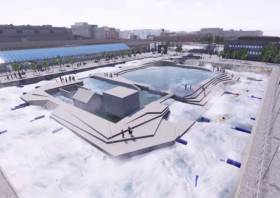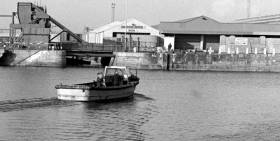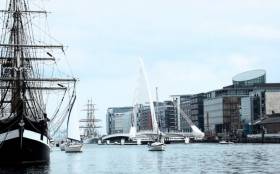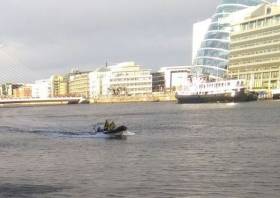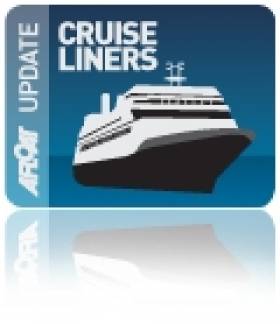Displaying items by tag: Dublin Docklands
Costs Double For Dublin City White Water Rafting Centre
Costs for the proposed white water rafting centre at George’s Dock have doubled to nearly €23 million, as The Irish Times reports.
The news comes as controversy over plans for the site in Dublin’s Docklands caused a storm on social media in reaction to a promotional video shared by Dublin City Council on Tuesday (26 November).
The ‘elite’ white water rafting circuit was first mooted in early 2018 when a design tender was issued as part of redevelopment plans for George’s Dock, adjacent to the IFSC in the city centre.
City councillors were presented with plans in January this year, with costs estimated at €12 million for a facility serving ‘elite kayak slalom’ squads, as well as training for emergency services besides potential recreational use.
Then Dublin Lord Mayor Nial Ring described the scheme as a “white elephant”. However, the plans returned to the fore this autumn following summer’s local elections and a public consultation was launched into the proposals.
Dublin City Council says the original cost estimate did not include design fees, site preparation costs or VAT liability, though it added that it intends to find the scheme from grants. Councillors will make the final decision on the project next month.
The Irish Times has more on the story HERE.
“Cross the Liffey in a Jiffy” in Dublin Docklands As Historic Ferry to Return After 35 Years
#dublinport - In Dublin’s Docklands, the historic No.11 Liffey Ferry otherwise known as the 'Dockers' ferry will today officially return to the capital’s waters after a 35-year absence.
The much-loved service that linked the north and south docks is to return following a complete restoration of the ferry in a joint project by Dublin Port Company and Dublin City Council.
The ferry was a vital link for the Liffey side communities at a time when the nearest river crossing was Butt Bridge but was decommissioned in 1984 following the completion of the East Link Bridge.
But now the No. 11 will be a familiar sight again in the heart of Dublin as she taxis passengers between three points - the 3Arena to Sir John Rogerson’s Quay to MV Cill Airne at North Wall Quay and back starting Monday 11th February, running Monday to Friday between 7am and 7pm.
On board today's relaunch will be the Lord Mayor of Dublin, Nial Ring, as a guest of honour at a ceremony held by Dublin Port Company to mark the No. 11 Liffey Ferry’s return to service.
Also coming on board for her first official trip across the river again will be Mr Richie Saunders from Ringsend, who worked on the No.11 originally as a coxswain, who was instrumental in preserving the boat in recent years, and who will be back at the helm again to ferry a new generation of passengers north and south of the river.
The service to cross the Liffey dates back to 1665 when it was given a Royal Charter by King Charles II and went on to last more than 300 years.
A capacity of 18 passengers will be taken on each crossing and the ferry service will also enable commuters across the Docklands. Fares for the trip will be €2 for each of the three-minute journey point to point – with the vessel equipped to accept both Leap Card and cash fares.
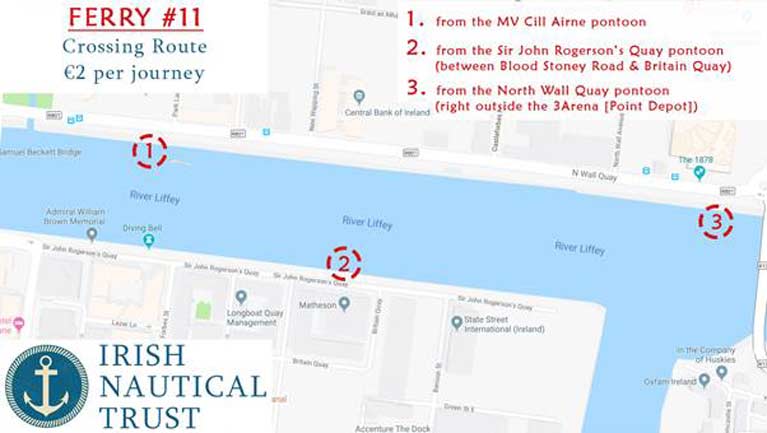 A map of the No.11 Liffey Ferry crossing route
A map of the No.11 Liffey Ferry crossing route
The No. 11 was essential transport for workers at the docks and became affectionately known by Dubliners as ‘the dockers’ taxi’. The boat was bought by Dublin Port Company in 2016, having been preserved by Richie Saunders with the aim of bringing her back to service. Operated by the Irish Nautical Trust, all proceeds from passengers’ fares will be used to help fund the return of a new maritime training programme.
The Irish Nautical Trust’s original maritime training programme, which has been dormant for the past 12 years, is now set to resume next month, and will offer young adults from the inner city and docklands areas the opportunity to gain practical marine experience and a formal qualification accredited by the Irish Sailing Association.
Each course will provide 8-10 people at a time with six months’ hands-on experience of the port, the wider maritime industry, driving, skippering, essential boat maintenance and repairs under the tutelage of experienced and retired seamen.
The objective of the programme is to give young people a skill set and future in Ireland’s maritime industry through learning by doing, with the No. 11 Liffey Ferry the new mascot of the programme. In this way, essential maritime skills now in short supply are less at risk of being forgotten or lost if they can be passed on to a new generation through formal training and mentoring.
Flotilla of Five French Navy Vessels On Visit
#NavalVisits - A flotilla of five French Navy vessels are currently on a call to the capital following the small ships arrival into Dublin Port yesterday morning, writes Jehan Ashmore.
Mine counter measures (MCM) vessel Cassiopée built in 1984 is of the Éridan-class. The class otherwise commonly known as the 'Tripartite' class, berthed downriver unlike the rest of the flotilla allocated along Sir John Rogerson Quay.
Accompanying the MCM Tripartite vessel displacing 615 tonnes are three sonar-towing training ships of the (BRS) type Antarès, the namesake of the leadship class which is in port. The remaining pair are Aldebaran and Altaïr. Each of the trio displace just 340 tonnes and were all commissioned in the 1990's.
The fifth visitor is represented by the Chamois class auxiliary Élan which among its duties serves as an anti-pollution vessel based in Cherbourg. The 400 displacement tonnes vessel with a large aft-deck is equipped with a hydraulic crane located at the stern. The veteran vessel in April, marked its 40th year since entering service in 1978.
An even older French Navy visitor was the Paimpolaise-class sail training ship Belle-Poule. The schooner dating to 1932 made an impressive sight during last Monday's Bank Holiday 'Parade of Sail' in Dublin Bay before heading for Bordeaux.
Berthing Licences Join White-Water Course As Part Of Draft ‘Water Animation Strategy’ For Dublin Docklands
#Docklands - The recent design tender for a white-water kayaking course at Dublin’s George’s Dock is part of a wider ‘Water Animation Strategy’ for the city’s Docklands.
Submissions are due this Tuesday 15 May for parties interested in another phase of the draft strategy — this time for vessels of historic or other interest to serve as visitor attractions on the Liffey quays.
Three locations have been identified by Dublin City Council for medium-term lease arrangements, including Custom House Quay at the pontoon immediately east of Sean O’Casey Bridge and immediately west of the Samuel Beckett Bridge, and City Quay immediately east of Memorial Bridge.
Among the proposals welcomed are for historic vessels with an association with the capital or its port; vessels with a community, arts, cultural or leisure purpose to attract visitors; tall ships, including replicas; and ‘visually interesting’ vessels.
Vessels are limited to no more than 50m in length and 7m in height above the water line, excluding masts, funnels, etc. Vessels proposed must be suitable for the location sought, and compatible with existing conditions.
Selections will be made from these expressions of interest for a second stage where applicants “will be invited to enter into competitive dialogue with Dublin City Council for a tender”.
Man Rescued From Liffey On Christmas Morning
#Rescue - Gardaí and Dublin firefighters rescued a man in his 20s from the River Liffey in Dublin’s Docklands on Christmas morning.
According to the Dublin Fire Brigade Twitter account, the man was kept afloat by gardaí with a life buoy till he was recovered by the fire service rescue boat at Sir John Rogerson’s Quay shortly before lunchtime yesterday.
1 person taken from the #Liffey by our rescue boat. @GardaTraffic used life buoy to keep person afloat, John Rogersons Quay #Dublin #fire pic.twitter.com/yQDBVxw7vO
— Dublin Fire Brigade (@DubFireBrigade) December 25, 2016
In other rescue news, TheJournal.ie looks at the Irish Coast Guard’s operations nationwide, co-ordinating the 1,000 volunteers who “face peril on every call out”.
Dublin Docklands Could Be 'Luxury Yachting Destination'
#Docklands - More than 1,200 jobs could be created by making Dublin's Docklands a destination for luxury maritime tourism, as The Irish Times reports.
That's the message from Docklands Business Forum chair Ciaran Flanagan, who claims that developing Grand Canal Basin and the bank of the Liffey opposite as a "world class luxury yachting destination" could bring "about €36 million into the local economy".
The story appears only weeks after Afloat's WMN Nixon asked the question in his weekly blog on Afloat.ie: Who Runs Dublin Bay, The Capital's Waterborne Playground?
Flanagan's comments come ahead of the Docklands Business Awards this Thursday 27 November, which he says "are a key platform to highlight the activity and invocation taking place in the Docklands area but also an important forum to underline the potential the area still holds."
Meanwhile, nearby Dun Laoghaire marina on the south shore of Dublin Bay has tweeted an image of its recent superyacht style visitors. In 2014 it has had a series of high profile visiting superyachts including Superyacht Christoper in June and Arcadia in September.
The Irish Times has more on the story HERE.
From Rigging to Gigging: The Jeanie Sessions
#MUSIC AFLOAT - The replica emmigrant barque Jeanie Johnston, is to embark with an exciting line-up of artists from all genres onto its timber decks. The unique music venue of the famine museum ship is located on Custom House Quay within the Dublin 'Docklands' quarter.
The next session on 20th October (7pm) is to be performed by Larry Beau. The Galwegian minstrel, composer and story collector will be accompanied by special guests to record the new album The Sundance Vagabonds live! on board the vessel.
The new album was written during a one year trip, from east to west coast America and was inspired by Peregrine White, the first-born to the Pilgrims when they arrived in the New World on the caravel Mayflower in 1620.
The sessions are held below decks in the main saloon where space is strictly limited to 80 persons. Advance booking online is recommended. Tickets are €15.00 and are available online through the Jeanie Johnston website by clicking HERE.
Open House Dublin takes to the Water
#OPEN HOUSE – Starting today is Open House Dublin weekend (5-7 October), which is an exploration of the vitality of Dublin through its architecture for people and to experience free of charge. A host of buildings otherwise normally closed to the general public are available to visit including maritime related tours.
An architectural tour of Dublin's Docklands quarter on board a Liffey sightseeing boat is to be presented by Minister for Education Ruairi Quinn T.D. Also taking transport while on a tour of buildings along Dun Laoghaire will be a yacht excursion along the south Dublin Bay coastline.
The Commissioners of Irish Lights, whose striking landmark headquarters in Dun Laoghaire Harbour, will be open to public tours. Further along the waterfront, close to the harbour's East Pier, is the National Maritime Museum of Ireland (NMMI) which is also to welcome visitors noting the opening hours on Sunday are between 11am to 5pm.
Please note that availability to these events which represent a handful in an extensive programme are subject to various viewing arrangements, as some had to be pre-booked, while others are based on a first-come first-served basis. For further details consult www.openhousedublin.com
Superyacht Makes A 'Majestic' Entrance
#SUPERYACHT – The elegant streamlined luxury 60m/200ft motoryacht M.Y. Majestic is to dock in Dublin’s Port this evening, having departed Norway via Scottish waters, writes Jehan Ashmore.
The Caymen Islands registered 12-guest charter-yacht (view gallery) which has a crew of 15 to serve clients normally in the warmer climes of the Caribbean and Mediterranean.
On her visit to Dublin she is to moor midway alongside Sir John Rogersons Quay in the heart of the 'Docklands' quarter.
The motoryacht has a skylounge, which offers private vantage point for bird’s eye views. From here guests have the option to convert the lounge into a cinema with a 100-inch screen and a choice of more than 800 on-demand movie titles.
She was built in 2007 by Feadship, the same Dutch yard that completed the M.Y. Air which called to Cork in May. Majestic has two VIP staterooms, in which the stateroom on the lower deck takes up the full beam (10.9m/34ft) and is approached by its own guest lounge. The other accommodation is for five double en-suite cabins.
As to be expected of the millionaires’ yacht, there is an extensive array of leisure toys on board, be it through the use of two tenders (over 23ft), 3-man wave-runners, hobie kayaks, waterskis, wakeboards, scuba equipment facilities for 8 persons and for those snorkelling up to 12. All this is backed up by a Zodiac rescue boat, however for those not wanting to get their feet wet there’s the gym!
She is powered by a pair of CAT 3516 engines which generate 2000hp (1492kw) each, which deliver a cruising speed of 14knots, though if required this can increased to 16 knots.
Homage Paid to Irish Founder of Argentinian Navy
#ADMIRAL BROWN- As Wexford is to host The John Barry Maritime Festival this summer, the father of the US Navy and commodore is held in the same league of Admiral William Brown, who founded the Argentinian Navy, who was remembered in a ceremony over the weekend in Buenos Aires, writes Jehan Ashmore.
The commemoration was to mark the 155th anniversary of William Brown's passing which took place at the Recoleta Cemetery, which was headed by Vice Admiral Carlos Alberto Paz, Chief of Staff of the Argentine Navy.
Among those attending were the Irish Ambassador, Mr. James McIntyre, the Chairman of the National Brownian Institute, Prof. Emilia Menotti, the President of the Naval Club, Vice Admiral Eduardo R. Llambi (Ret.) and City Council Officials.
The Navy General Directorate for Education marching band was also present, as well as Officer Cadets from the Admiral Brown Naval Lyceum (Reserve Officers' Academy). The Irish flag was carried alongside the host country by officers of the HQ Security Marine Bn.
For more about the event which included Santiago L. Aversa who represented the Irish branch of the Maritime Institute of Ireland (click HERE) and where its maritime museum in Dun Laoghaire is due to reopen early next month as previously reported on Afloat.ie
In 2006 the Naval Service 'flagship' L.É. Eithne (whose adopted homeport is Dun Laoghaire) under the command of Commodore Mark Mellett, made a historic first for the Naval Service when visiting Argentina and other South American ports.
In the same year two identical statues of the admiral were unveiled, one in Dublin's Docklands at Admiral Brown Way and Westport, Co. Mayo where the admiral hailed from.
Admiral Brown won victories against the Spanish and Brazilian fleets and as such he is regarded as a national hero, where in excess of 1,000 streets, 400 statues and venues such as stadiums (including football teams) schools, several towns, and a major city bears his name.
- naval service
- Argentinian Navy
- L.E. Eithne
- Commodore John Barry
- Admiral William Brown
- Commodore Mark Mellett
- M.I.I.
- Maritime Institute of Ireland
- Mariners Church Dun Laoghaire
- Maritime Museum Dun Laoghaire
- Dublin Docklands
- The John Barry Maritime Festival
- Admiral Brown Way
- Irish Ambassador McIntyre
- Westport Co Mayo
- Wexford Town



























